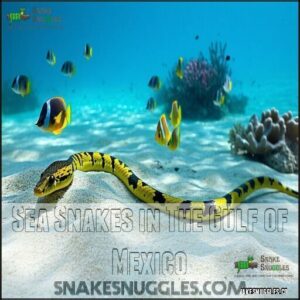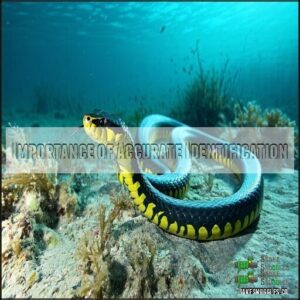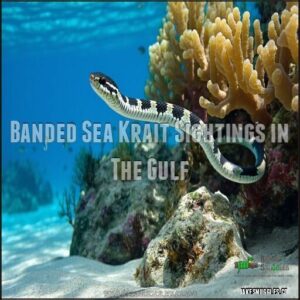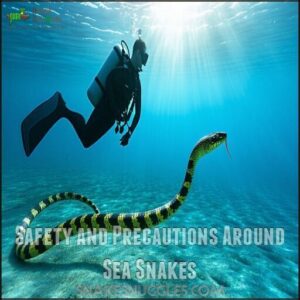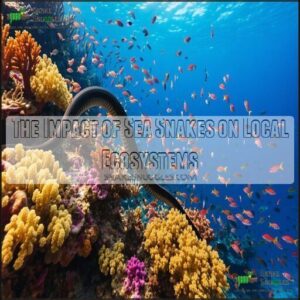This site is supported by our readers. We may earn a commission, at no cost to you, if you purchase through links.

They often get mistaken for harmless eels, so it’s important to know their distinct paddle-like tails and banded patterns.
Scientists suggest they might have entered the Gulf through changing currents or ship ballast water.
While encounters are unusual, giving them space keeps everyone safe, and it’s crucial to understand their venomous bite.
Curious about their unique habits or how they affect local ecosystems? Stay tuned.
Table Of Contents
- Key Takeaways
- Sea Snakes in The Gulf of Mexico
- Identifying Sea Snakes in The Gulf
- Types of Sea Snakes Found in The Gulf
- Sea Snake Behavior and Habitat
- Safety and Precautions Around Sea Snakes
- The Impact of Sea Snakes on Local Ecosystems
- Frequently Asked Questions (FAQs)
- How long after a bite from a sea snake does it take effect?
- Are Gulf Salt Marsh snakes poisonous?
- Are there sea snakes in the Gulf?
- Are there sea snakes in Mexico?
- Do sea snakes live in the Gulf of California?
- What happens if sea snakes come to the Gulf?
- Are sea snakes in the Gulf of Mexico?
- Are there poisonous sea snakes in Mexico?
- How aggressive are sea snakes?
- Do sea snakes live in Mexico?
- Conclusion
Key Takeaways
- You’re unlikely to find true sea snakes in the Gulf of Mexico; most sightings are misidentified snake eels or floating debris.
- Yellow-bellied sea snakes might enter the Gulf via ocean currents or ballast water but remain rare and non-native.
- If sea snakes appeared more frequently, they’d likely disrupt ecosystems through competition and altered predator-prey dynamics.
- Always keep a safe distance from any sea snake-like creature, as some can deliver highly venomous bites.
Sea Snakes in The Gulf of Mexico
You’ll find that despite widespread reports of sea snake sightings in the Gulf of Mexico, scientific evidence strongly indicates these are typically misidentifications of similar-looking species such as snake eels.
Snake eels, often mistaken for sea snakes, dominate Gulf reports, proving nature’s mimicry can trick even seasoned sailors.
While the yellow-bellied sea snake has been occasionally documented in these waters, true sea snakes aren’t native to the Atlantic Ocean or the Gulf, with confirmed sightings remaining extremely rare and often attributed to unusual climate patterns or ship ballast water transport, which can be considered unusual climate patterns.
Historical Sightings and Reports
Since the early 1900s, the Gulf of Mexico has been awash with mysterious sea snake sightings that continue to perplex marine biologists.
Early Gulf reports from 1901 documented what appeared to be a "100-foot sea serpent" near the Mississippi River entrance, though modern research suggests this may have been a misidentified oarfish.
Historical sightings in the Gulf have fueled both scientific inquiry and local legends about these elusive creatures.
When you hear about these serpentine visitors, remember these key factors affecting sighting authenticity:
- Mistaken identity is common, with snake eels frequently confused for actual sea snakes
- Rare sightings often lack photographic evidence or scientific verification
- GulfSERPENT research indicates many historical accounts were likely deep-sea oarfish
- Verified sightings remain extremely uncommon despite persistent anecdotal reports
While early 20th-century studies suggested nine sea snake species inhabited Gulf waters, distinguishing fact from fiction in historical snake sightings continues to challenge scientists.
Possible Entry via Ballast Water
Sea snakes might be hitching rides right into the Gulf of Mexico through ship ballast water.
These hidden stowaways represent one of the most concerning invasion pathways for non-native species.
| Ballast Water Risks | Monitoring Challenges |
|---|---|
| Yellow-bellied sea snakes survive long journeys | Detection methods limited |
| Regulation effectiveness varies globally | Ships discharge millions of gallons |
| Marine biosecurity threats increasing | Tracking species survival difficult |
Despite international regulations requiring mid-ocean water exchange, these measures aren’t foolproof.
Ships traveling between the Pacific and Gulf inadvertently transport these venomous passengers, creating potential ecological disruptions.
As shipping traffic increases, so does the likelihood of successful invasions, making ballast water management essential for preventing establishment of these dangerous reptiles.
Current Research and Investigation
Dozens of marine researchers face significant research challenges when investigating alleged sea snake sightings in the gulf of mexico.
Genetic analysis reveals surprising hidden diversity in declining Gulf populations that require urgent conservation needs.
- Scientists employ DNA testing to distinguish between native marine species and possible Pelamis platura specimens.
- Advanced tracking methods map potential habitats affected by climate change.
- Researchers analyze water samples to identify environmental factors influencing potential snake migration patterns.
Future studies will determine if documented specimens represent established populations or occasional visitors.
Their paddle-like tails aid in efficient swimming.
Identifying Sea Snakes in The Gulf
You’ll need to recognize the key features that distinguish genuine sea snakes from common lookalikes in Gulf waters, including their paddle-shaped tails and fluid swimming motion.
While reported sightings have increased, many observations actually involve harmless native species such as snake eels, which share similar markings but lack the distinctive flattened tails of true sea snakes.
Distinguishing Features and Behavior
While exploring Gulf waters, accurate snake identification becomes essential for your safety.
True sea snakes display distinctive features that set them apart from common look-alikes:
| Feature | Sea Snake | Common Look-alike |
|---|---|---|
| Tail | Flattened, paddle-like for tail propulsion | Round or tapered |
| Body | Streamlined bodies with valved nostrils | Lacks marine navigation adaptations |
| Behavior | Graceful swimmers, rarely aggressive | Often erratic movements |
Their venom toxicity varies by species, though encounters are uncommon.
Most species exhibit live birth in marine habitats rather than laying eggs—a fascinating adaptation to their fully aquatic lifestyle.
Learning about sea snake recognition is vital for those working or recreating in their habitat.
When observed, note their elegant swimming pattern and distinctive flattened tail—key identification markers during unexpected encounters.
Common Misidentifications and Look-Alikes
When identifying movement in Gulf waters, don’t be fooled by common lookalikes masquerading as sea snakes.
The magnificent snake eel is particularly deceptive, with its spotted or striped body and serpentine swimming pattern near the ocean floor. Many reported sea snake sightings are actually misidentifications of these harmless creatures.
Watch for these frequent Gulf of Mexico imposters:
- Snake Eels: These slither along the seafloor in snake-like motions but are completely harmless
- Floating Debris Mimics: Sargassum mats often undulate like swimming snakes
- Juvenile Snakes: Young water snakes can resemble smaller sea kraits
- Banded Patterns: Many harmless native species display similar coloration
Remember, all reports of banded sea kraits in the Gulf represent misidentifications, as these creatures live far from U.S. waters.
These snakes could potentially arrive via ship ballast systems.
Importance of Accurate Identification
The ability to correctly identify sea snakes in the Gulf of Mexico serves as a cornerstone of public safety and conservation efforts.
Misidentifications—confusing marine reptiles with snake eels or floating debris—create serious conservation implications and skew scientific data.
Use these Identification Methods:
Mastering species differentiation guarantees accurate sighting verification, supporting both research integrity and your safety during Gulf encounters.
Types of Sea Snakes Found in The Gulf
You’ll encounter primarily two sea snake species if you’re exploring the Gulf of Mexico: the yellow-bellied sea snake with its distinctive coloration and the occasionally reported banded sea krait, though many sightings are misidentifications of native snake eels.
Scientists continue to monitor these potential invasive species closely, as their presence could substantially impact the Gulf’s delicate marine ecosystem.
The monitoring is crucial because the presence of these species, such as the banded sea krait, could have significant effects.
Yellow-Bellied Sea Snake Distribution
The yellowbellied sea snake (Pelamis platura) boasts the most extensive global distribution of any snake species, thriving in tropical Pacific and Indian Ocean waters.
While not native to the Gulf of Mexico, oceanic currents occasionally transport these highly venomous swimmers across vast distances.
Their remarkable adaptability to changing habitats and climate influence allows them to survive in diverse marine environments.
You’ll find these pelagic reptiles floating in large groups along surface current convergences, sometimes forming aggregations of thousands.
Banded Sea Krait Sightings in The Gulf
While yellow-bellied sea snakes gain attention, banded sea kraits create even more confusion in Gulf waters.
Despite numerous reported sightings, scientific evidence confirms these striking black-and-white striped serpents aren’t native to the Gulf of Mexico.
Most reports stem from krait misidentification, with snake eels—Gulf residents with similar markings—often the real culprits.
The validity of sighting claims remains questionable, as these venomous look-alikes typically inhabit western Pacific regions, not Atlantic waters.
Snakes control rodent populations, playing a pivotal role in local ecosystems.
- Snake eels in the Gulf closely resemble banded sea kraits in pattern and movement
- No confirmed evidence supports krait introduction or ocean migration to Gulf ecosystems
- Experienced fishermen occasionally report sightings, but verification remains elusive
Other Sea Snake Species and Their Ranges
Contrary to popular belief, true sea snakes aren’t native to the Gulf of Mexico or Atlantic Ocean.
Despite reported sightings, scientific evidence confirms these marine reptiles remain confined to the Indian and western Pacific oceans. You’ll find sea kraits exclusively in Pacific habitats like the Coral Triangle, not cruising Gulf waters.
Reports of snakes with paddle-like tails near Sabine Pass have fueled speculation.
| Species | Native Region | Notable Characteristics |
|---|---|---|
| Hydrophis spiralis | Indian Ocean | Aggressive hunter, never Atlantic |
| Pelamis platurus | Pacific to Americas | Most widely ranging, pelagic |
| Spiny-headed snakes | Pacific coral reefs | Specialized hunting tactics |
| Turtlehead sea snakes | Indo-Pacific | Fish egg diet, shallow waters |
What you’ve spotted might be misidentified snake eels, which resemble sea kraits but aren’t venomous saltwater snakes. No sea snake ocean migration brings these species into the Gulf of California or beyond, and they are not venomous saltwater snakes.
Sea Snake Behavior and Habitat
You’ll find sea snakes perfectly adapted to life in the ocean, with paddle-like tails that let them glide through saltwater effortlessly.
Their behavior, from hunting small fish to mating in warm, tropical waters, shows how well they’ve mastered their unique habitats, with warm being a key factor.
Saltwater Environments and Swimming Abilities
Sea snakes are true saltwater specialists, perfectly suited for an aquatic lifestyle with their remarkable swimming mechanics.
Sea snakes thrive in the ocean, gliding effortlessly with paddle-shaped tails, showcasing nature’s perfect design for marine survival.
Their paddle-shaped tails act like underwater oars, propelling them through waves with hydrodynamic efficiency. You’d be amazed at how streamlined their bodies are—they cut through water like a hot knife through butter, minimizing drag to conserve energy.
These snakes also display expert buoyancy control, effortlessly traversing saltwater environments where conditions can be unpredictable. Their saltwater adaptations, like specialized osmoregulation strategies, keep them thriving in complex marine ecosystems.
Their skin also facilitates cutaneous respiration, allowing them to absorb oxygen directly from the water.
- Paddle-shaped tails provide powerful propulsion.
- Streamlined bodies enhance hydrodynamic efficiency.
- Osmoregulation strategies guarantee survival in salty waters.
It’s like they’re built for underwater mastery!
Feeding Habits and Prey
In regards to their meals, sea snakes in the Gulf of Mexico showcase impressive dietary adaptations that make them stealthy predators. They thrive on a diet of fish prey and eels, using precision foraging strategies and venom usage to quickly subdue their targets.
Imagine them as the sharp-eyed chefs of the Gulf, choosing their meals with care—an accurate balance of Gulf diet staples.
Prey selection isn’t random; they actively maintain the marine food chain by keeping fish and eel populations in check. Their feeding habits, powered by highly effective venom, create balance underwater.
Sea snakes’ role as nature’s venom-armed hunters guarantees ecosystems stay healthy, proving just how intricate—and important—a snake diet can be.
Mating and Breeding Patterns
Marine reptiles like sea snakes have enchanting mating and breeding patterns.
During the breeding season, males impress females with energetic courtship rituals—a mesmerizing display of wriggling.
These ovoviviparous creatures showcase unique reproduction methods, skipping egg-laying entirely.
Instead, females undergo internal incubation with remarkable gestation periods, giving birth to live young.
Neonates, tiny and independent, are immediately ready for life’s challenges.
This approach guarantees reproductive success, adapting perfectly to the ocean’s demands, balancing survival instincts with the unpredictability of marine waters.
Safety and Precautions Around Sea Snakes
When you encounter a sea snake, keeping your distance is essential to avoid accidental bites from their highly venomous fangs.
Wearing protective gear in the water and staying calm reduces risks while ensuring your safety around these fascinating but dangerous creatures.
Venom Potency and Human Attacks
A sea snake’s venom potency is no small matter—some are deadlier than cobras.
Thankfully, human attacks are rare, mostly affecting fishermen handling nets.
Snake bites can cause neurotoxic symptoms like paralysis, so seek immediate care if bitten.
Venom evolution has made them efficient hunters, but antivenom can counteract their bite.
Want prevention? Respect their ocean and keep your distance—it’s the best first aid!
Giving Sea Snakes Space and Avoiding Provocation
In the context of marine reptile encounters, think of sea snakes as introverted swimmers who prefer a Respectful Distance. Stay at least 5-10 feet away to avoid provocation triggers like poking, chasing, or blocking their path. These reptiles exhibit Non-Aggressive Behavior and only strike if cornered.
Here are some quick Encounter Tips:
- Observe their sleek swimming from a safe distance—no need to get up close!
- Avoid provoking them; no touching, herding, or trapping.
- Stay alert and calm in the water for maximum Water Safety.
Safe encounters rely on mutual respect. Watch, learn, and let these swimmers move freely.
Wearing Protective Clothing When Diving or Swimming
Staying safe while exploring waters with sea snakes starts with the right clothing materials.
A snug wetsuit provides thermal regulation and shields your body from venomous strikes.
Dive suits enhance buoyancy control and fend off stings from jellyfish or scrapes with coral.
Neoprene gloves protect your hands while giving you a better grip underwater, and water boots guard your feet against sharp objects lurking below.
For added visibility underwater, a brightly colored safety vest is a smart choice.
Think of it as your underwater armor—it doesn’t just protect; it boosts confidence.
Gear up, and let your adventure be safer and stress-free!
The Impact of Sea Snakes on Local Ecosystems
You’ll find sea snakes have the potential to shake up the balance of native ecosystems, preying on local species and competing for resources.
Scientists are studying their impact closely, as even small changes could ripple through the food web in unexpected ways.
Potential Effects on Native Species
If sea snakes creep into the Gulf of Mexico, they could unsettle the ecosystem in sneaky but significant ways.
Their presence would likely trigger competition dynamics, battling native species for food and shelter, while ramping up predation pressure on local prey.
This cascade of changes could lead to visible shifts in the food web.
Here’s what might happen:
- Food web impact from altered predator-prey connections.
- Habitat alteration, stressing native critters.
- Diseases carried by new, invasive species.
- Loss of biodiversity from resource competition.
Their potent venom relies on three-finger toxin genes to subdue prey.
Research on The Ecological Consequences of Sea Snakes
When invasive species like sea snakes enter new waters, researchers study their ecological impact scrupulously.
In the Gulf of Mexico, you might wonder how these predators affect marine ecosystems.
Here’s what they’re analyzing:
- Prey populations: Are fish and crustaceans disappearing where these snakes hunt?
- Food web: Could their appetites unravel the balance reef ecosystems depend on?
- Competition: Are native predators losing out, leading to species declines?
- Habitat alteration: Do they pose risks to delicate reefs or seagrass beds?
Understanding these factors helps protect the Gulf’s biodiversity and guarantees its food webs remain intact.
Frequently Asked Questions (FAQs)
How long after a bite from a sea snake does it take effect?
Symptoms from a sea snake bite can take 30 minutes to several hours to show, depending on the venom’s potency and amount injected.
Muscle pain, weakness, or paralysis are warning signs needing urgent care.
Are Gulf Salt Marsh snakes poisonous?
Imagine spotting a Gulf Salt Marsh snake along the shoreline—it’s nonvenomous, so you’re perfectly safe.
These snakes rely on camouflage and eat small prey like fish and frogs.
They’re harmless but fascinating marsh residents!
Are there sea snakes in the Gulf?
You won’t find true sea snakes in the Gulf of Mexico—they’re not native to the Atlantic.
Reports of sightings often turn out to be misidentified snake eels, which are harmless but similarly patterned.
Are there sea snakes in Mexico?
Yes, Mexico’s Pacific coast is home to sea snakes, like the yellow-bellied sea snake.
However, no true sea snakes are native to the Gulf of Mexico, where sightings usually involve other species or misidentifications.
Do sea snakes live in the Gulf of California?
In the shimmering waters of the Gulf of California, sea snakes thrive, especially due to its warm, tropical conditions.
You’ll find notable species like the yellow-bellied sea snake, perfectly adapted to this vibrant marine environment.
What happens if sea snakes come to the Gulf?
If sea snakes enter the Gulf, you’d see shifts in marine food webs, potential risks to fishermen due to venom, and fascinating opportunities for research.
They’d thrive in warm waters but might disrupt local ecosystems.
Are sea snakes in the Gulf of Mexico?
True sea snakes aren’t native to the Gulf of Mexico.
Occasional sightings, like the yellow-bellied sea snake, occur due to ocean currents or misidentifications.
Don’t worry—they’re uncommon and not a local concern!
Are there poisonous sea snakes in Mexico?
While Mexico’s tropical waters host venomous sea snakes like the yellow-bellied sea snake, encounters are rare.
These snakes aren’t aggressive, but their potent venom makes them fascinating creatures you’d want to admire from afar!
How aggressive are sea snakes?
Think of sea snakes as underwater introverts—they won’t bother you unless provoked.
Despite their potent venom, they’re shy and avoid humans, striking only when feeling trapped or threatened.
So, keep your distance, and you’re safe! They are generally not aggressive, but it’s crucial to respect their space to avoid any potential threat.
Do sea snakes live in Mexico?
You won’t find true sea snakes in Mexico’s waters, as they inhabit the Pacific and Indian Oceans.
However, occasional sightings, like yellow-bellied sea snakes, occur due to ocean currents or misidentifications of other marine creatures.
Conclusion
It’s almost like sea snakes in the Gulf of Mexico are making a headline-worthy debut in their unexpected new habitat.
As these venomous swimmers, like the yellow-bellied sea snake, continue to appear, it’s clear they bring both intrigue and ecological challenges.
Recognizing their paddle-like tails and keeping your distance is key to coexisting safely.
These rare yet fascinating creatures remind us of nature’s unpredictability and the importance of staying informed about the evolving ecosystems around us.
- https://www.susanscott.net/jul08-05/
- https://fishgame.com/2018/07/new-info-on-sea-snakes-in-gulf-of-mexico/
- https://a-z-animals.com/blog/discover-the-snakes-that-live-in-the-gulf-of-mexico/
- https://highercalling.net/2018/05/23/have-sea-snakes-entered-the-gulf-of-mexico/
- https://mdsearchlight.com/wilderness-and-environmental/sea-snake-toxicity/

